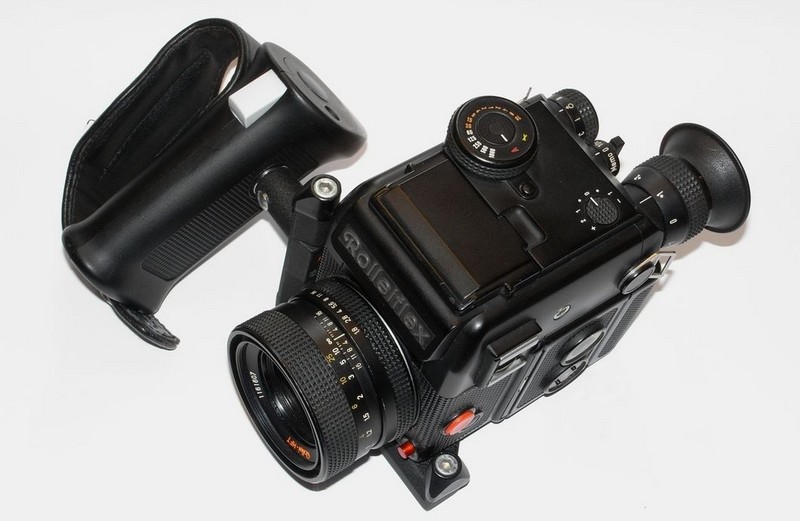Rolleiflex 4x4 (1957)
Looking at a photo of Reinhold Heidecke, it
seems
immediately obvious that he was a stubborn man, a millionaire, a gifted
engineer but also a simple man. He had released a number of 4x4 cameras
for
production before, and again in 1957, when a significant part of the
target
customer group was already using 35mm film. How absurd – an
expensive camera
without finder but with a dark WLF, without the possibility to change
lenses,
without meter and with a film format with very limited availability.
Rollei had
all the assets to make a successful 35mm camera – money
(Rollei was the
biggest camera maker,
by a large margin), resources, know how… This would
have been the time to realise where the photographic world was really
heading,
and make the right decisions to continue to play a leading role in it.
But no,
only over my dead body was Heideckes verdict.
Admittedly, the 4x4 is a cute camera, but it is
also a
monument of bad management.
Rollei A26 (1974)
As such, the A26 is a well-designed camera, it
cannot
be held responsible for the shortcomings of the 126 film cassette (that
does
not keep the film flat well enough). The lens is sharp indeed; with
some luck
it is able to produce very fine pictures. But how can one justify a
price tag
of over 400 Deutsche Mark for a camera that does not allow any control
over its
operation apart from setting the distance, not even exposure
correction?
Rollei A110 (1974)
Again, a well-made camera, a “palm
stone”, that
however proved to be very delicate, due to its soft aluminium shell.
But this
camera also meant inevitable customer annoyance! Imagine a man,
solvent, maybe
even a Rollei owner, walking into a camera store, looking for a compact
camera,
for himself, for his wife, maybe even for his car… He
doesn’t want the Rollei
35, for its complicated operation, but Rollei doesn’t have a
less complicated
35mm camera in its product line-up (why, on earth?). Instead, the
dealer sells
him a A110, and a pocket cassette full of film for 548 Deutsche Mark
(unbelievable but true, at product introduction), knowing that the
customer
will inevitably end up with very bad pictures, because the 110
“pocket” format
is just too small for decent quality (also see the Pentax auto110), in
any case
it will never produce anything adequate to the price of the camera. Not
very
likely that this customer will buy a Rollei again…
Rolleiflex SLX (1976)
The SLX isn’t odd, it is unique! An
icon, the
forefather of a camera line that stretches until today, many years
ahead of its
time at introduction, if not decades. The fact that Rollei had to
design so
many things from scratch (shutter, electronics, the whole concept)
almost broke
the neck of the camera, and Rollei – years went by from
introduction to
actual availability, and the first cameras weren’t reliably
either…
Of course, this is a matter of taste, but I
have owned
a 6008 and a 6003 – and eventually the SLX stayed with me.
Rolleimatic (1980)
Apart from the fact that almost all these
cameras are
meanwhile defunct due to failing electronics, the question must be
asked what
Rollei was up to with this camera? It is a pretty sophisticated thing,
its
mechanics are unique and it must have been pretty costly to develop it
and make
it ready for production – while it offers no advantages at
all (almost) and it
even is a pretty boring camera, with nothing to adjust except for the
subject
distance, which in turn you have to do without any help, so a high
percentage
of unsharp pictures is guaranteed.
Claus Prochnow comments in his Rollei Report
about
Heinz Waaske (the designer) having all the freedom at Rollei after his
huge
success with the Rollei 35, and that Rollei was anyway in desperate
need of new
products to fill its Singapore plant – well, this is how this
camera was
created, at a time when there were already autofocus cameras on the
market,
even from Rollei (rebadged Japanese cameras), while the Rollei engineers were
busy designing film transport flaps…
Rolleiflex
SL 2000 F motor
(1981)

The SL2000 expresses the creativity and the
engineering
skills of the people at Rollei, but it also speaks of the hectic pace
in the
seventies, when Rollei desperately tried to secure (or to regain) its
top place in
the photographic world.
In any case it is also proof that common sense
and/or
market research were not always Rollei’s strong points.
As impressive as the camera features add up on
paper,
when using it for the first time the user will be disappointed (if not
shocked)
by its unhandiness. With the grip, the experience may be more pleasant,
but (as
Jan Boettcher wrote) if a camera definitely needs a grip, it can be
assumed
that there is something wrong with the camera design in the first
place. Even
Rollei realized this a couple of years later and presented the 3003,
which
improved the ergonomics by a large margin.
At the time, I really wanted
to love the SL2000, this was in the midst of my Rollei trip,
but the Pentax LX just is the better camera…
Something
even Rollei tried in the early days of the
digital age is to make a digital back. If Rollei was still alive, and
the SL2000/3003, this would have been the only 35mm camera where a
digital back
would have made sense.
Odd Pentax Cameras
Other Odd Cameras
